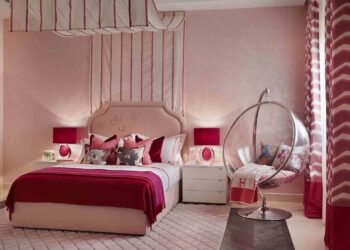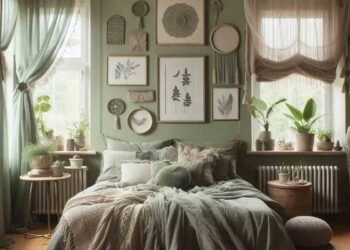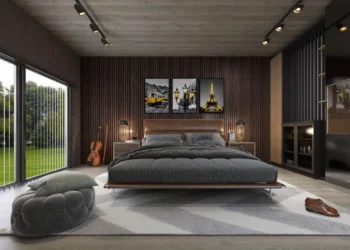Squeezing two beds into a small room can turn out cute and functional when you get the layout right. The key is finding that perfect balance between comfort and style without making the space feel cramped.
Light colors work well in the small spaces like soft whites, gentle pastels, or cool neutrals that make walls seem to recede. When you pair these light shades with pops of contrast through pillows or artwork, you create a room that feels open yet has personality and depth.
The right bed arrangement transforms how a room functions. A thoughtfully planned layout makes all the difference between a crowded, awkward space and one that flows naturally.
These settings work beautifully with different design styles from minimalist to boho to traditional. Add smart storage solutions, proper lighting, and personal touches, and a small bedroom becomes a spacious one.
I’m going to take you through 22 amazing arrangement ideas 2 beds in one small room ideas. Whether you’re setting up a kids’ room, a guest space, or a dorm situation, these ideas will help you maximize every inch while keeping things stylish and practical.
22 Arrangement Ideas 2 Beds in One Small Room Ideas
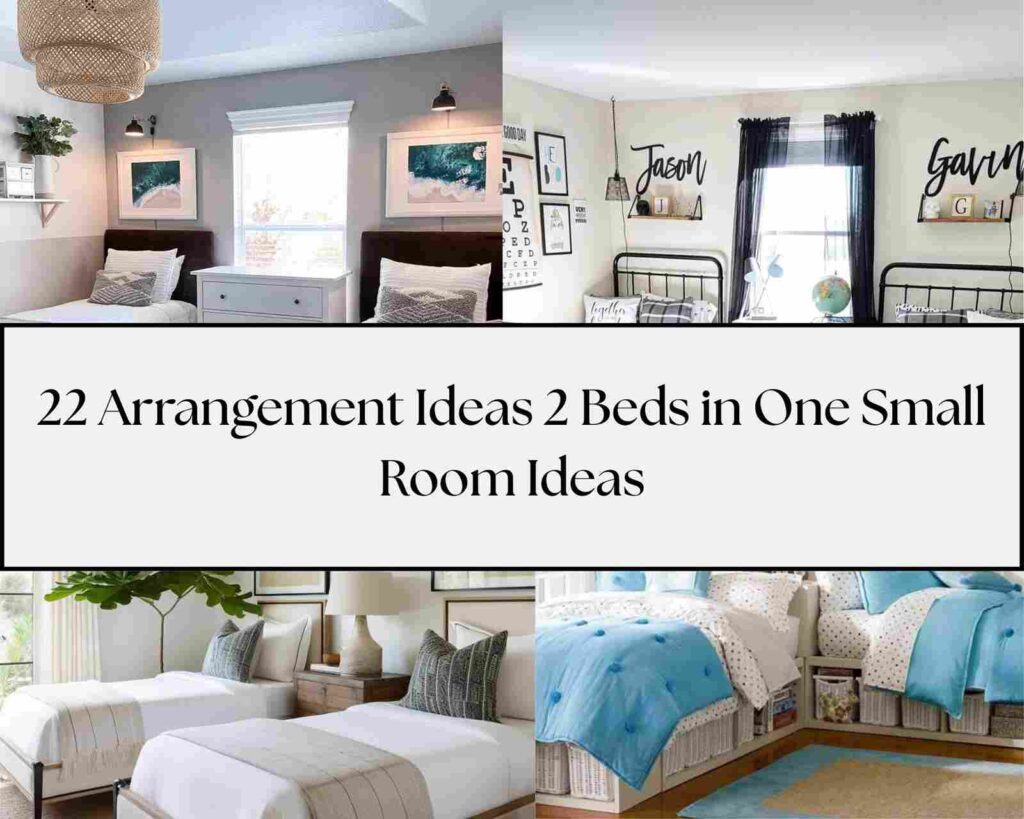
Before diving into each arrangement, know that the perfect setup depends on your room’s unique shape, window placement, and who’ll be using the space. These arrangement ideas 2 beds in one small room ideas range from classic layouts to space-savers that’ll work in any room size.
So, let’s go and find out the best one for you.
Place twin beds with storage
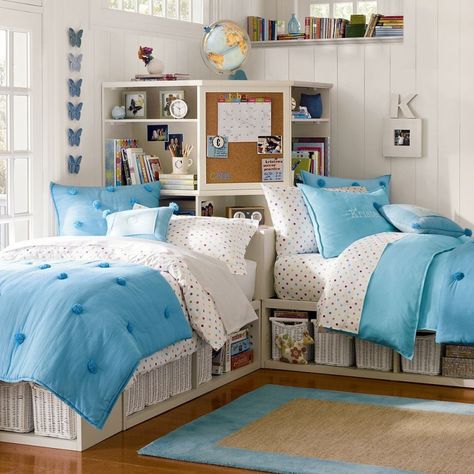
Twin beds with built-in storage drawers are GAME SAVERS in small spaces. These smart beds let you tuck away seasonal clothes, bedding, or toys. The beauty of this setup is you’re combining two furniture pieces into one, a bed and a dresser which is brilliant when footage is tight.
To make this work, measure your space and leave space between beds for movement. Look for platform beds with drawers that pull out from the sides rather than the foot of the bed.
I love this solution for kids’ rooms. Not only does it teach children to stay organized with their own storage space, but it also grows with them. Unlike space-saving solutions we’ll talk about, storage beds remain practical for every type.
Go for L-shaped arrangement
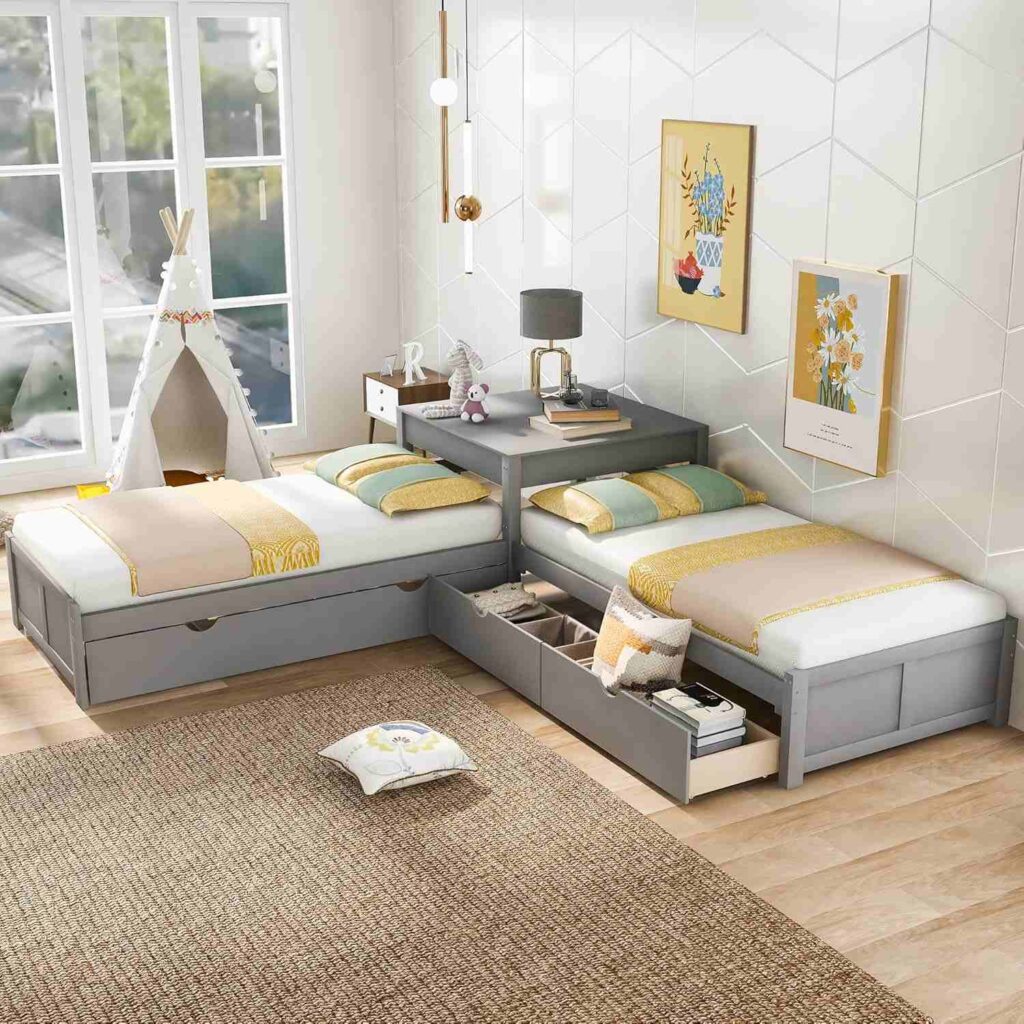
An L-shaped bed arrangement is one of my favorite layouts for small rooms. By positioning the beds perpendicular to each other in an L-formation, you create an open area in the center of the room.
For the best setup, place one bed along the long wall and the other along the short wall with their corners meeting. Add a corner nightstand or small table where the beds meet, this shared surface works for both sleepers and tie the arrangement together.
What I find cool about this arrangement is how it divides the room into zones without any furniture. Each bed gets its own wall space for personalization, and the corner becomes a cozy nook that feels separate from the rest of the room.
Opt for loft with bed underneath
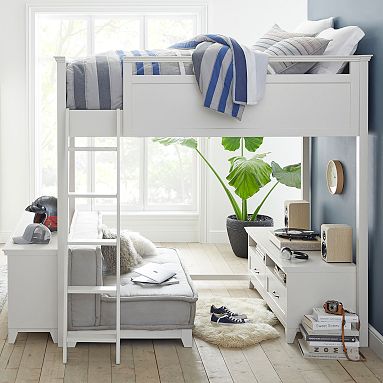
A loft bed with a bed tucked underneath is like finding hidden space in your room. This vertical arrangement takes advantage of ceiling height instead of floor space. The top bunk serves as a regular sleeping space while the bottom area becomes flexible.
I think this setup offers the flexibility of all the arrangements. The bottom space can transform into a cozy reading nook, study area, or play zone during the day. This makes it perfect for rooms that need to serve multiple purposes or for kids who have friends to sleep over.
Utilize bunk beds
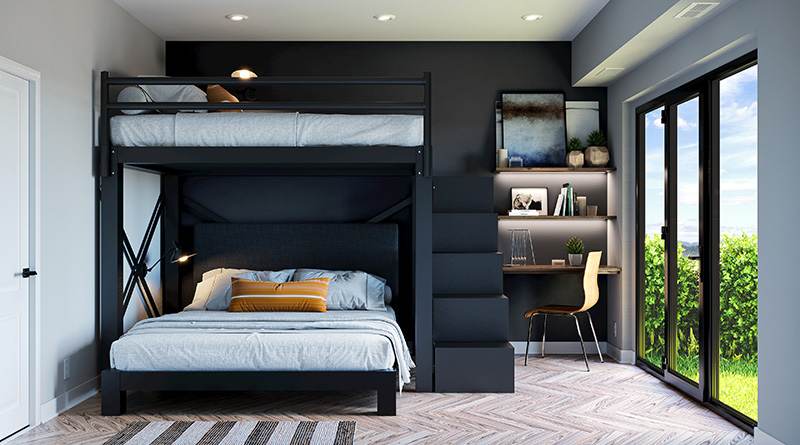
Classic bunk beds never go out of style, they’re the space-savers. Stacking two beds vertically frees up floor space, giving you room for other furniture like desks, dressers, or play areas. Modern bunks come in countless styles from simple metal frames to wooden structures with built-in storage.
Safety comes first with bunks, so look for models with construction, secure guardrails on the top bunk, and a stable ladder. Place the bunk bed against a wall for stability. Add clip-on reading lights for each level so both sleepers can control their own lighting.
I’m a fan of how bunks create a fun, camp-like atmosphere in a bedroom. For personality, try hanging different curtains around each bunk or using contrasting bedding to give each sleeper their own space.
Consider parallel iron beds
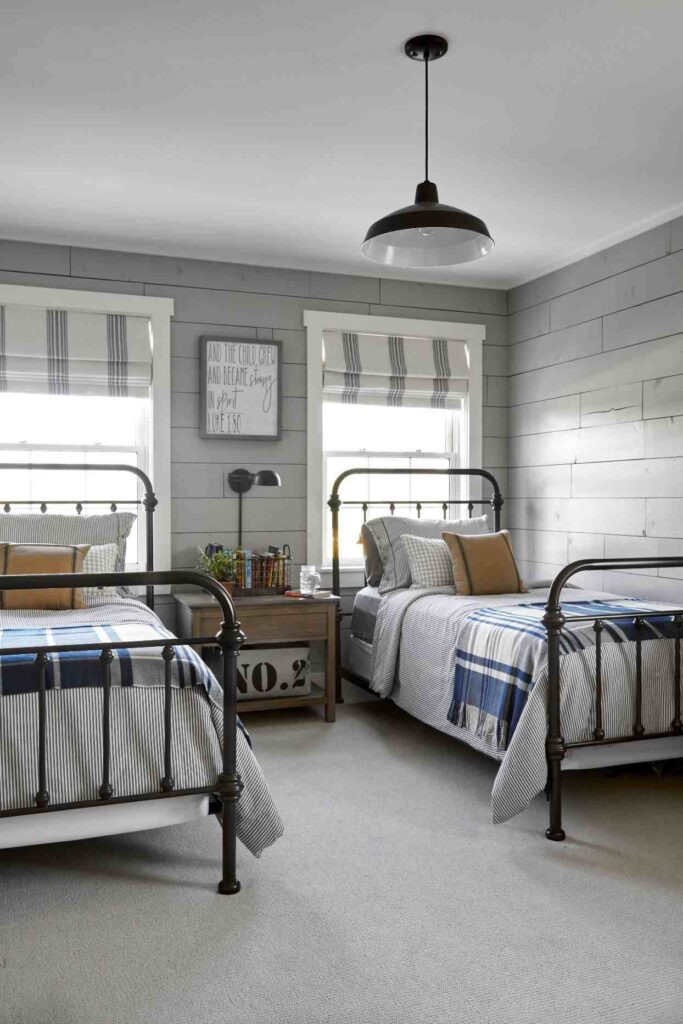
Matching iron beds parallel to each other create a lovely, timeless look that works in any style home. There’s something charming about twin iron beds with their open, airy frames. They bring a touch of vintage charm while feeling fresh and current.
For the pleasing arrangement, center the beds on your long wall with a shared nightstand between them. Iron beds pair beautifully with white linens for a clean look, or you can add colorful quilts for a cottage-inspired feel.
What I appreciate about iron beds is their versatility across different ages and styles. They work well in a guest room as in a kids’ room, and they transition beautifully as children grow up. The simplicity of the frames means you can change the look of the room by swapping out bedding and accessories.
Go for head-to-head
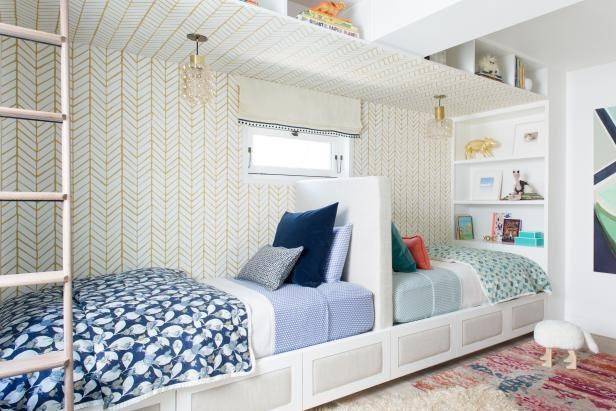
Arranging twin beds head-to-head creates a unique setup that’s perfect for narrow rooms. Instead of the traditional side-by-side layout, this places beds so they share a headboard wall.
To implement this, position both beds with their headboards against the same wall. Place a shared nightstand or small dresser between the headboards that both sleepers can use. This arrangement works best against a windowless wall so the bed blocks natural light.
Each person gets their own area of the room too. To enhance this arrangement, consider painting a bold accent color on the headboard wall or hanging a large piece of artwork that unifies the two bed spaces while adding visual interest.
Consider shared upholstered headboard
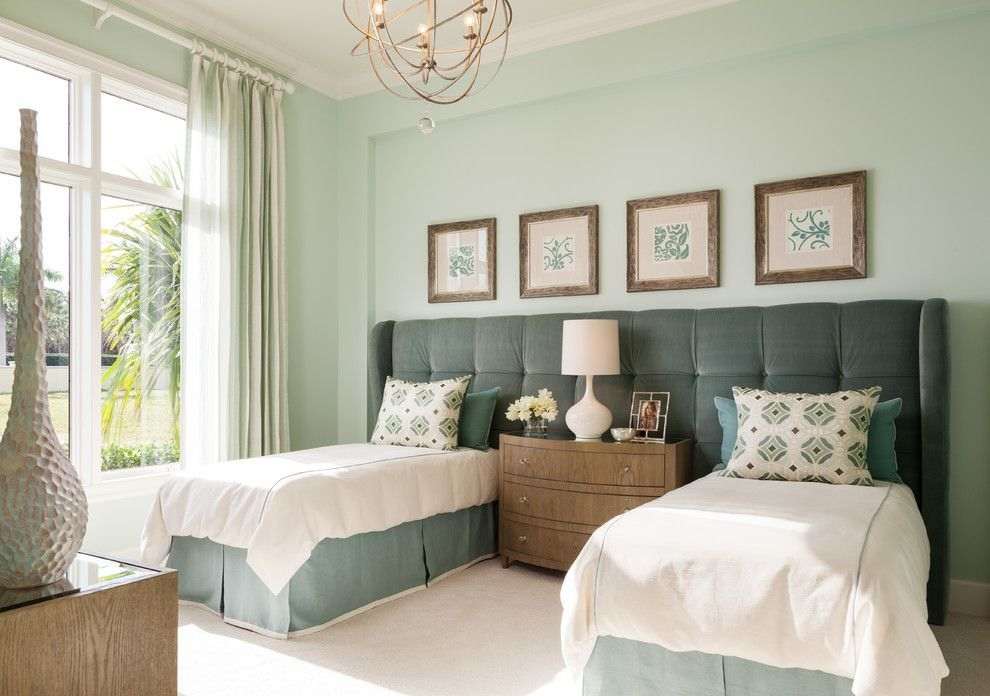
An upholstered headboard spanning two twin beds creates a luxury bedroom feel in the small rooms. This design trick makes separate beds look cohesive and can make a room appear wide. The soft upholstery adds warmth and comfort while serving as a focal point.
I love how sophisticated this looks. It’s perfect for creating a high-end room feel on a budget. For a touch of luxury, add individual wall sconces above each bed instead of table lamps to save nightstand space. This arrangement feels special and intentional rather than like you were forced to have two beds into a space.
Twin beds with built-ins
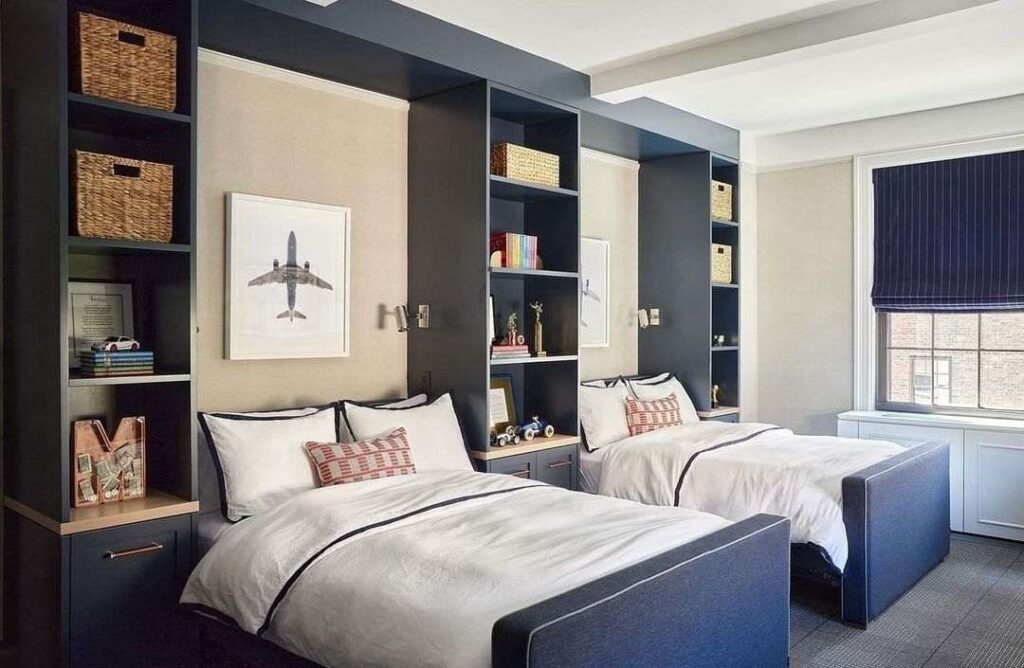
Built-in cabinetry surrounding twin beds creates a custom, high-end look that maximizes space. Think of each bed nestled into its own nook with storage cabinets above and drawers. It’s like creating two cozy sleeping alcoves within one room, and it looks amazing.
What makes this arrangement special is how it transforms an ordinary room into something that feels custom and thoughtful. Kids love the feeling of sleeping in their own nook. Add LED strip lighting under the overhead shelving for a magical touch.
Opt for shared lamp
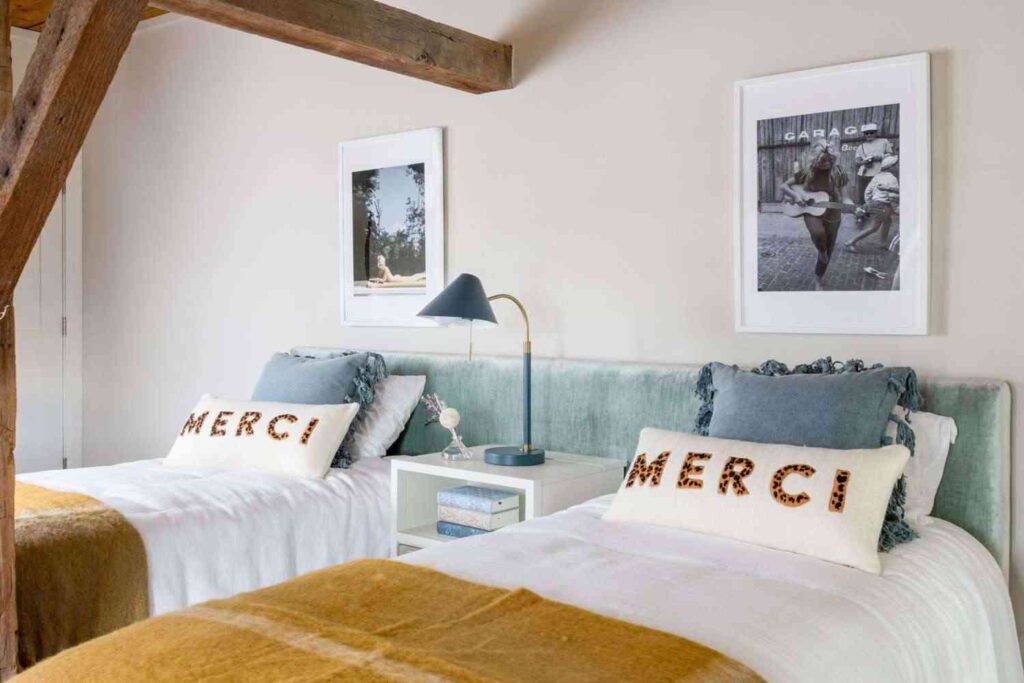
A single statement lamp positioned between two beds isn’t practical but it’s a design opportunity. This shared lighting solution saves surface space while creating a focal point that ties the two sleeping areas together.
Choose a lamp with brightness to serve both beds, a large table lamp on a shared nightstand or a floor lamp with an arm that can direct light where needed. Position it between the beds for balance. For an integrated look, select a lamp style that complements your overall room design but stands out to serve as a focal point.
I’m a fan of this space-saving trick because it adds a layer of intentional design to the room. Rather than cramming in two, the single lamp becomes a unifying element.
Place twin beds together
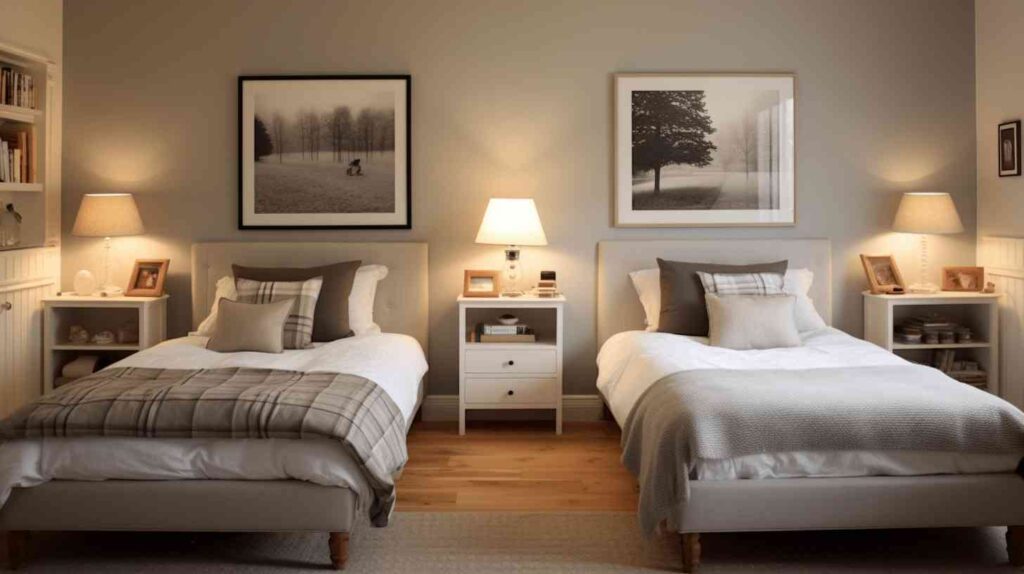
Pushing twin beds side by side to create one large sleeping surface offers flexibility. The twins function as separate beds, but they can transform into a king-size sleeping area when needed. This setup is brilliant for guest rooms or vacation homes where you need adaptable sleeping arrangements.
To create a cohesive look, use matching bed frames at the same height and add a bed bridge connector between mattresses to fill the gap. Choose bedding that works both ways, matching twin sets that look coordinated side by side, or a single king coverlet that can span both beds when pushed together.
What I love about this 2-in-1 solution is how it allows a room to evolve based on who’s using it. It’s more practical than having a dedicated guest room with a queen bed that sits empty .Plus, when the beds are separated, you create a spacious feeling in the room.
Hang pair of wall sconces
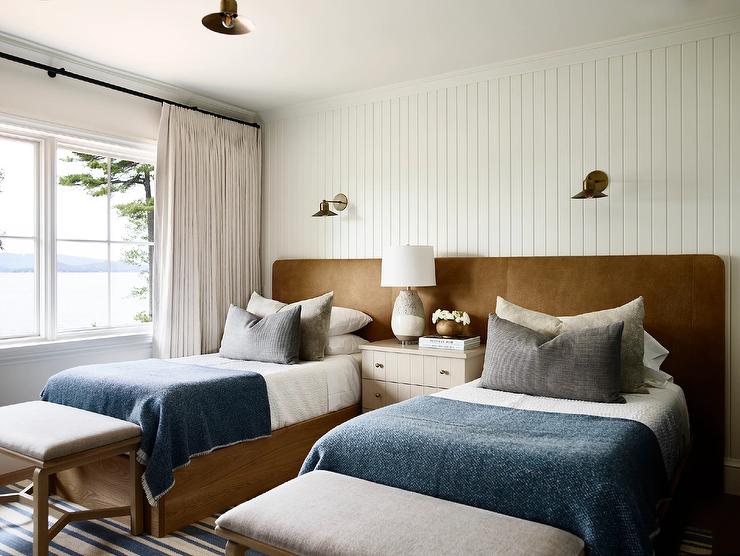
Wall-mounted sconces above each bed free up nightstand space and add a touch of sophistication. These fixtures bring the perfect combination of function and style, providing directed light where you need it without taking up surface area in a small room.
I’m amazed at how this one change can completely transform a bedroom’s look. Sconces add an architectural element that makes the simple room feel designed and intentional.
Use curtains for privacy
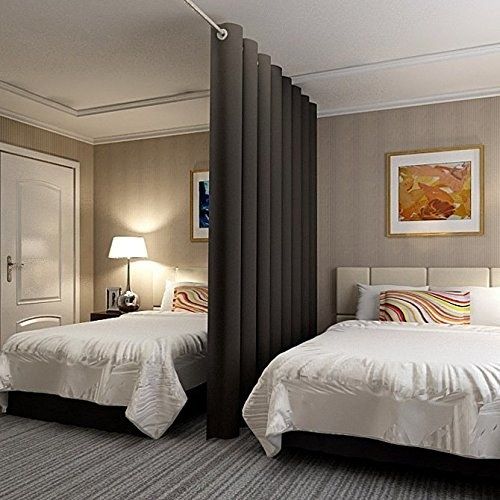
Hanging curtains between two beds creates instant privacy zones in a shared bedroom! This simple addition gives each person their own defined space without permanent walls or bulky furniture dividers. The soft fabric adds texture to the room while serving a practical purpose.
Install a ceiling-mounted curtain track or rod that allows the curtain to be pulled closed between the beds when desired and pushed back. Choose fabric with weight to it for better sound absorption and privacy.
What I find clever about this solution is its flexibility. They add a cozy, tent-like quality that kids love. For a special touch, string fairy lights along the curtain rod to create a magical glow when the curtains are closed.
Consider wall canopies
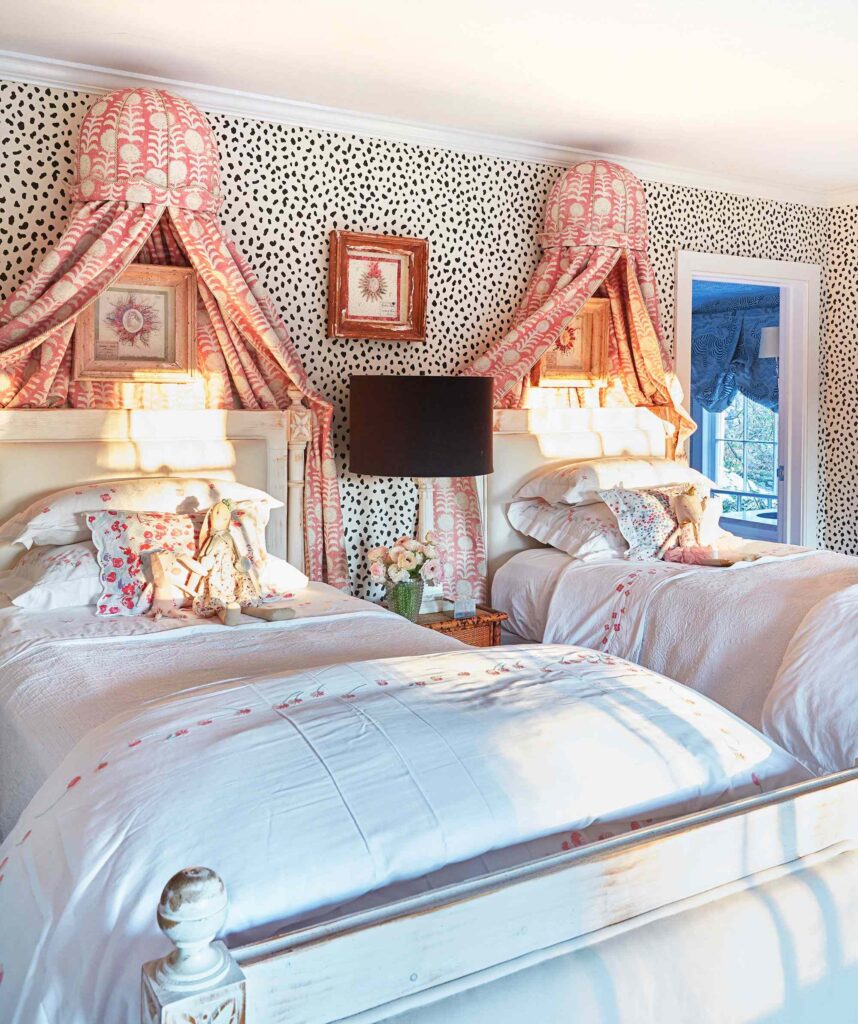
Individual wall canopies mounted above each bed create a magical, defined sleep space without taking up floor space. The fabric drapes attached to the wall or ceiling add texture, color, and a sense of luxury while giving their own speciality.
To create this look, install a half-circle or quarter-circle curtain rod on the wall above each headboard. Hang flowing fabric that complements your bedding, allowing it to drape gracefully around the head of the bed. For a cohesive look, choose the same fabric for both canopies, or for a personalized approach, select coordinating fabrics that reflect taste.
I adore how canopies make a bedroom feel magical and special. They work for ALL ages too from princess-loving toddlers to teens wanting a boho vibe to adults creating a boutique hotel feel.
Create gallery wall for personal touch
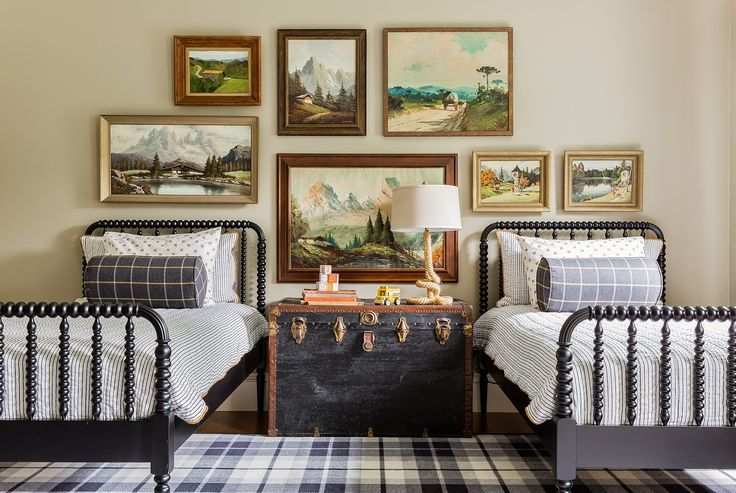
Creating a personalized gallery wall above each bed lets everyone express their personality. These mini art collections become like visual headboards that define each person’s territory while adding color, pattern, and meaning to the room.
Start by allocating equal wall space above each bed. Choose frames that coordinate for a cohesive look, even if the art inside differs. Help each person select images that reflect their interests like family photos, sports memorabilia, favorite quotes, artwork.
What makes this idea special is how it honors individuality within a shared environment. My favorite approach is keeping the beds, furniture, and main color scheme consistent while letting gallery walls be the expressive elements that differentiate each person’s space.
Incorporate plants as natural element
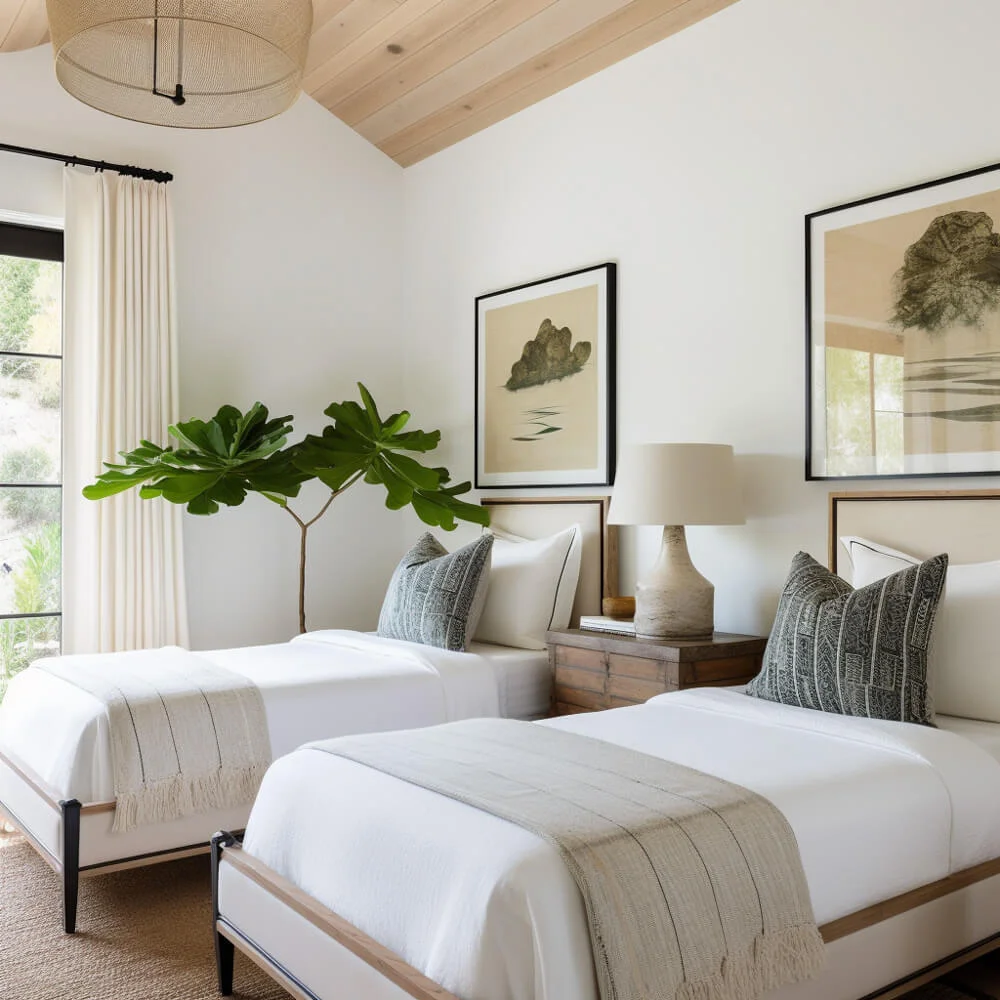
Adding houseplants to a room with two beds brings life, texture, and better air quality to shared spaces. Plants are natural dividers that create visual separation without solid barriers. They add height and dimension to a room while making it feel fresh and vibrant.
Choose plants based on the room’s light conditions and experience level. For spaces between beds, consider tall plants like snake plants or small fiddle leaf figs that create natural dividers. Hanging plants work wonderfully to define individual spaces without using floor space.
I’m a fan of greenery in bedrooms. Plants have a magical way of making rooms feel peaceful and put-together.
Place storage ottoman with bed
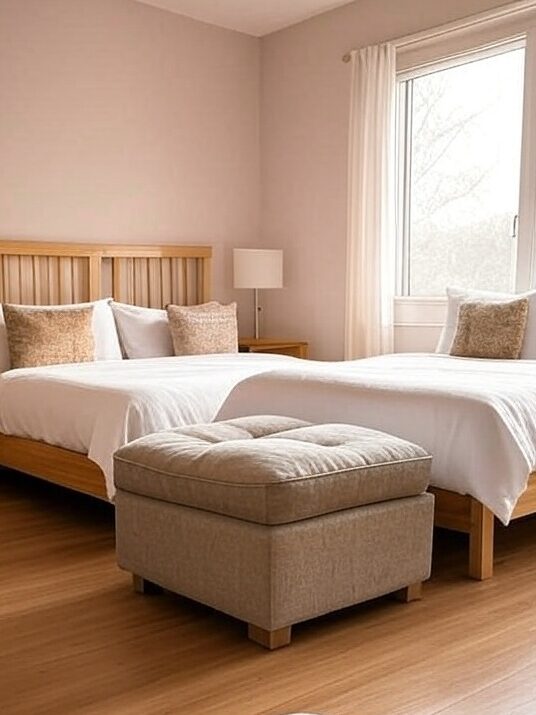
Storage ottomans at the foot of each bed add function, style, and seating in one compact package. These multi-tasking pieces provide the perfect spot to stash blankets, seasonal clothing, or toys while creating a finished look.
What I love about adding ottomans is how they upgrade the look of twin beds from basic to intentionally designed. They create this built-in bench feeling that makes simple bed frames look custom and high-end. They’re perfect perches for putting on shoes, dropping backpacks after school, or sitting to chat with your roommate.
Anchor space with rugs
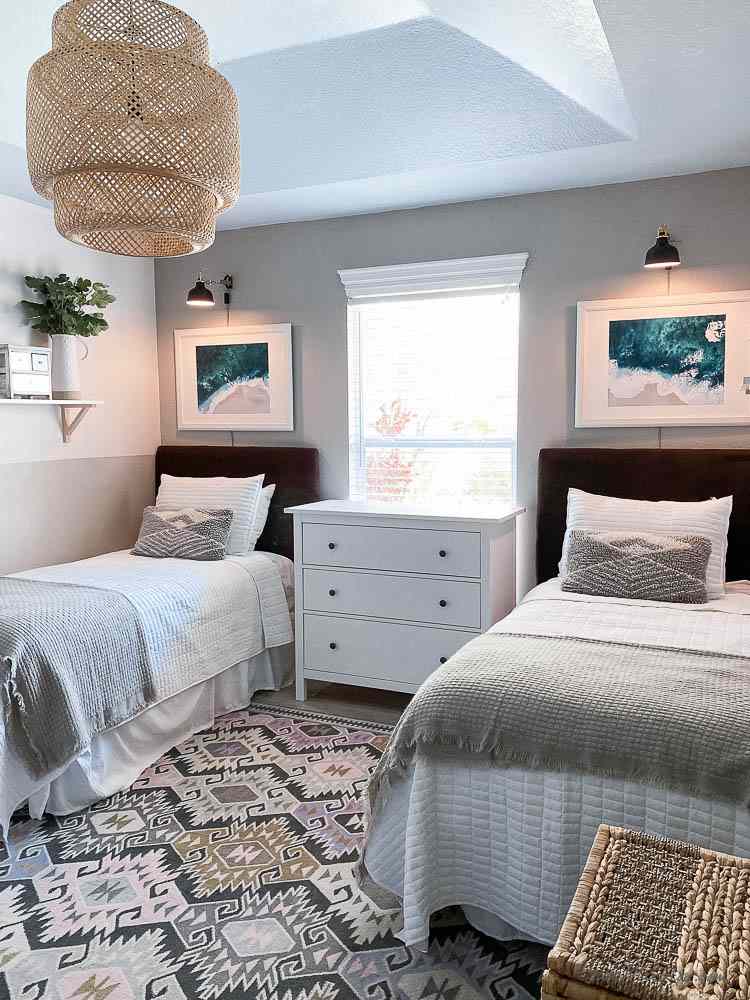
Individual rugs under each bed create defined zones that separate shared space. These textile anchors do double duty, warming up floors while creating psychological boundaries that help everyone feel like they have their own territory.
I love how rugs make each bed feel like its own “room” within the shared space. They add warmth, color, and texture while absorbing sound. If you have kids, consider washable rugs that can handle the spills and messes. And don’t forget that rugs provide a perfect opportunity to tie together different color schemes if the room’s have different style preferences.
Use paint to divide space
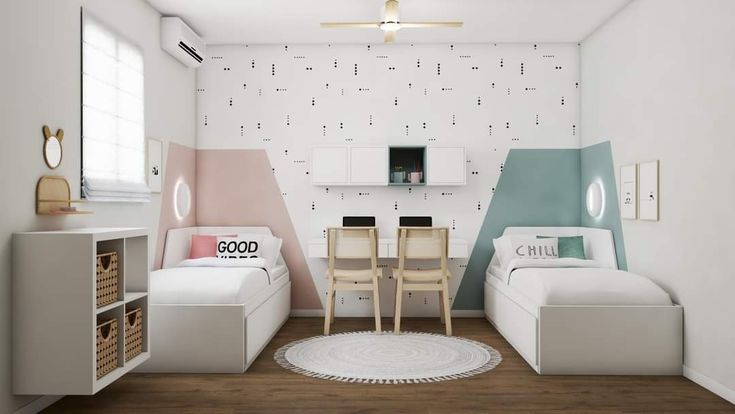
Using different paint colors or an accent wall behind each bed creates visual separation without barriers. This paint trick helps define individual territories while adding personality and style to the room. It’s like creating two spaces that feel cohesive and intentional.
For the effective application, paint the wall behind each bed in a different but complementary color. Choose shades from the same color family for a subtle difference or contrasting colors for dramatic separation.
What I find clever about this approach is how it costs little but delivers big results. Paint is the cheapest way to transform a room, yet it changes how the space feels. Keep the rest of the room cohesive with unifying elements like similar bedding or shared artwork to ensure the space feels pulled together despite the different wall colors.
Customise with names
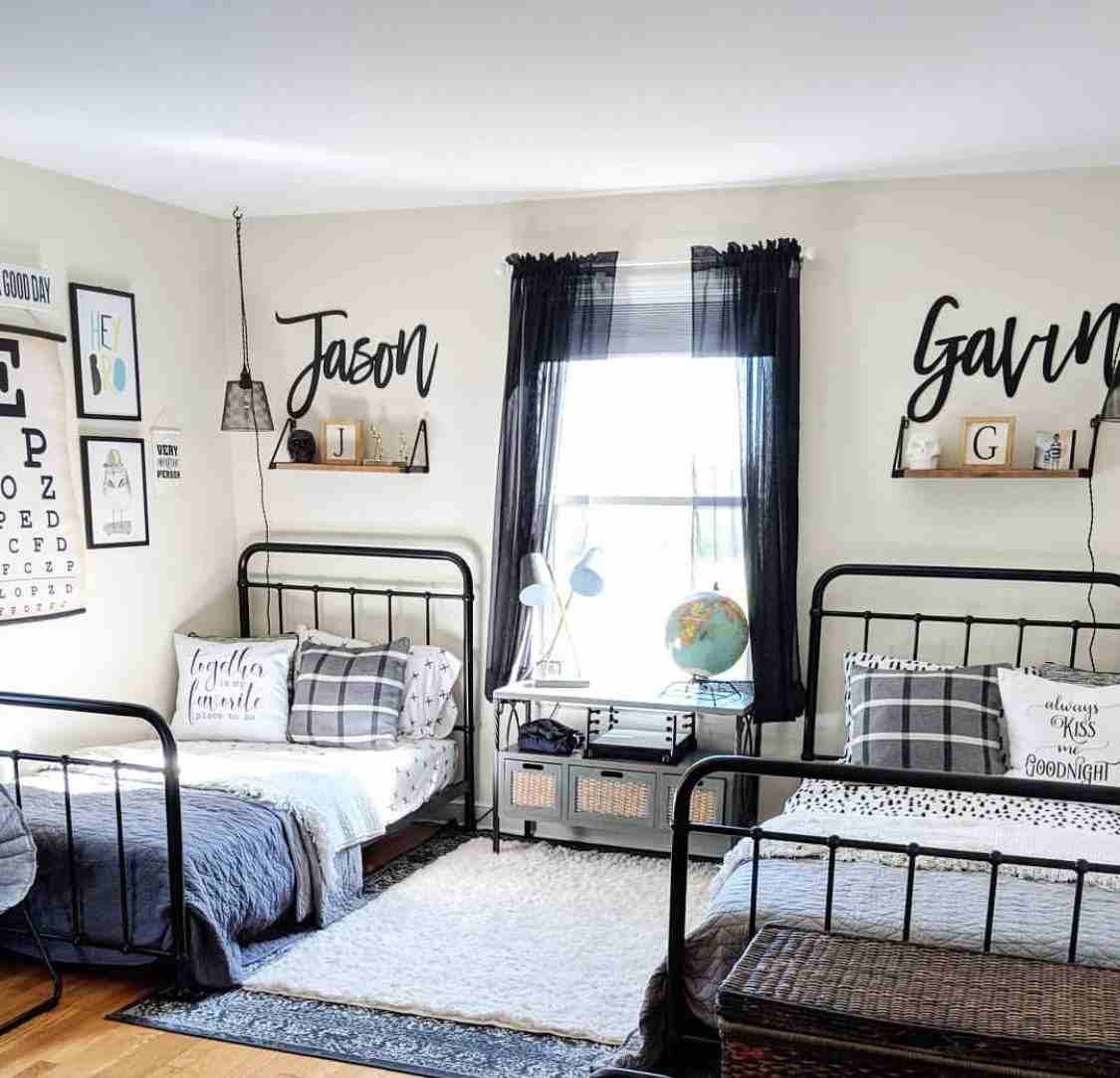
Adding personalized name displays above each bed creates both decoration and clear territory markers in shared rooms. These name features become focal points that celebrate individuality while adding a decorative element to the walls. They make each area feel special and designated to a person.
You’ve got options for displaying names like wooden or acrylic letters mounted on the wall, custom neon signs, framed name prints, fabric banners, or painted onto the wall. Choose a style that fits the room’s overall design but reflects each person’s personality.
I love this personal touch in shared bedrooms. There’s something affirming about seeing your name displayed in your space, especially for kids. For a cohesive look that honors individuality, use the same material or font style for both names but in different colors that coordinate with bedding or accessories. This creates the perfect balance between unity and personalization.
Go for floating shelves to display
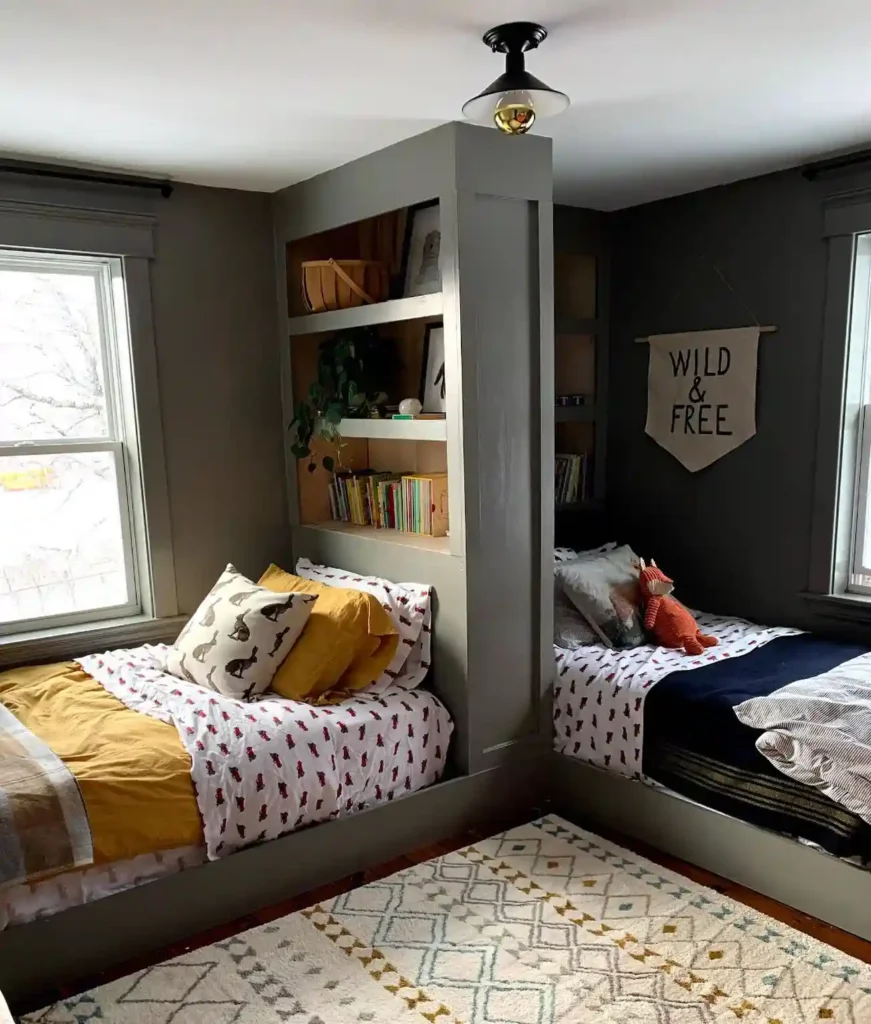
Floating shelves installed above each bed create personal display space without taking up floor space. These wall-mounted wonders provide the perfect spot for books, photos, treasured objects, and small plants that reflect personality.
What makes shelves a brilliant addition to shared bedrooms is how they give everyone space for their personal items. This is important in rooms where storage is communal. I love suggesting that each person curate their shelf displays with items that bring them joy, it becomes this evolving personal expression that can change as they do.
Use multipurpose furniture
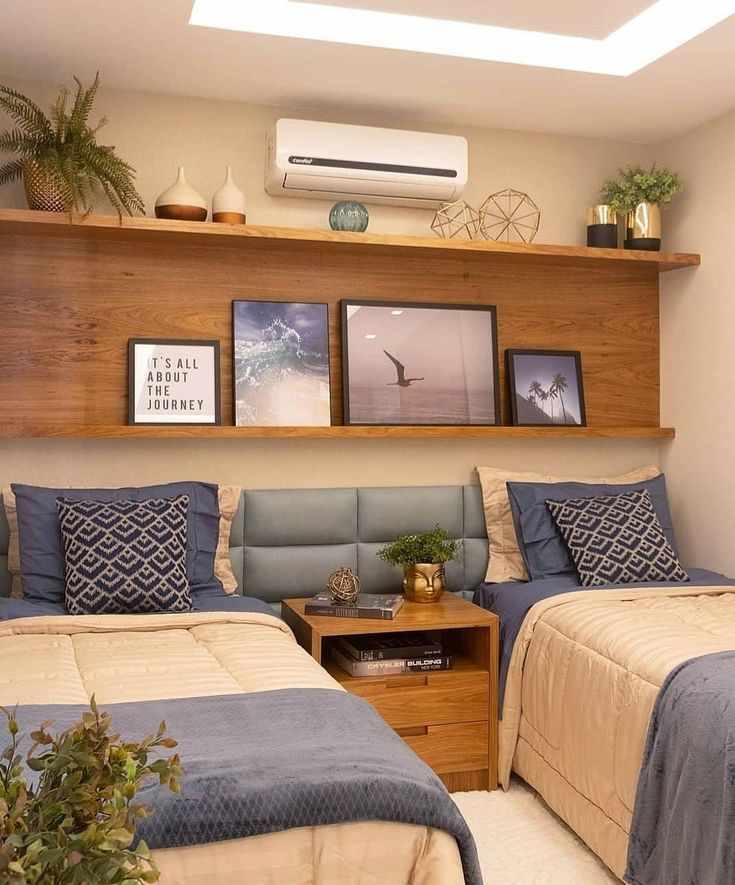
Multipurpose furniture pieces pull double or triple duty in rooms with two beds. These furnishings combine functions like a nightstand with a charging station, a desk that converts to sleeping space, or an ottoman that opens for storage and flips to become a table.
Look for pieces designed with multiple functions like bed frames with built-in desks, nightstands with hidden charging stations, headboards with lighting and shelving, or seating that converts to sleeping space for guests.
I’m a fan of this approach to furnishing small shared bedrooms. The key is choosing multipurpose items that perform all their functions well. For shared kids’ rooms, look for furniture systems that can adapt as needs change, like loft beds with desk space underneath that can be converted to standard beds with the same parts.
Choose sliding doors to divide space
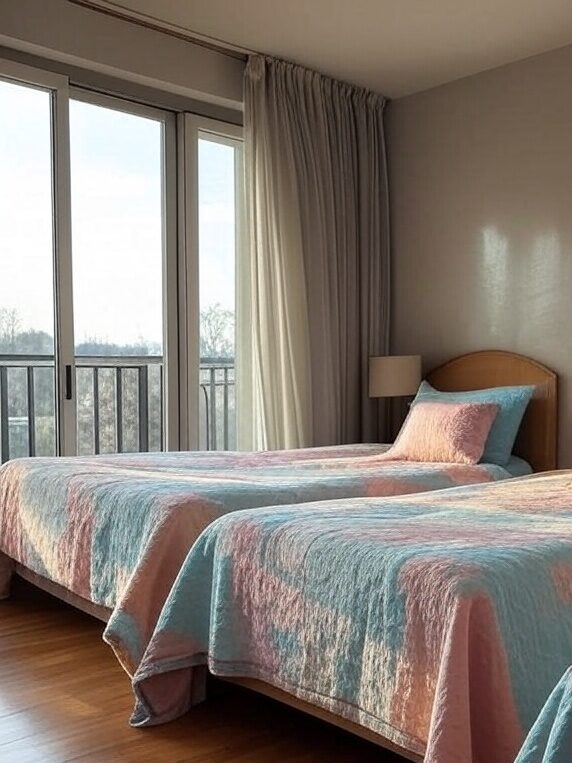
Sliding doors or panels create flexible division in rooms with two beds without the space requirements of swinging doors. These movable dividers allow for privacy when closed and full use of the room when open. They’re the perfect middle ground between open sharing and permanent room division.
What I find brilliant about sliding dividers is their adaptability to changing needs. Throughout the day, the room can transform from open for playtime or socializing to or divided for homework, quiet time, or sleeping. This flexibility makes the space work hard for you. For the functional setup, consider adding sound-dampening materials to your sliding panels; this thoughtful touch allows one person to sleep while the other reads or studies.
Conclusion
Fitting two beds into a small room doesn’t have to mean cramped or boring design. The successful small shared bedrooms combine smart space planning with personal touches.
Try mixing these designs together like loft beds with curtain dividers or parallel beds with personalized gallery walls above each one. The possibilities are endless.
Don’t be afraid to get creative and let the room evolve over time. The best shared spaces balance togetherness with individual expression, creating a room where everyone has their own space.
With these arrangement ideas 2 beds in one small room ideas, you’ve got options to create a space that’s functional, personal, and beautiful. Remember that the arrangement depends on your room dimensions.











